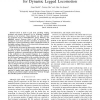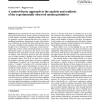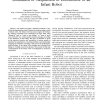567 search results - page 6 / 114 » Analysis of optimal control models for the human locomotion |
BC
2002
13 years 9 months ago
2002
Abstract. How do humans achieve the precise positioning of the feet during walking, for example, to reach the first step of a stairway? We addressed this question at the visuomotor...
IROS
2006
IEEE
14 years 3 months ago
2006
IEEE
— There is much to gain from providing walking machines with passive dynamics, e.g. by including compliant elements in the structure. These elements can offer interesting propert...
VRST
2004
ACM
14 years 3 months ago
2004
ACM
In this paper, we propose a new method for simulating reactive motions for running or walking human figures. The goal is to generate realistic animations of how humans compensate...
BC
2005
13 years 9 months ago
2005
Recent experiments on frogs and rats, have led to the hypothesis that sensory-motor systems are organized into a finite number of linearly combinable modules; each module generates...
IROS
2006
IEEE
14 years 3 months ago
2006
IEEE
Abstract— The authors proposed a simulation method to clarify the developmental process of human locomotion using a model of infant robot. The infant robot has many degrees of fr...



